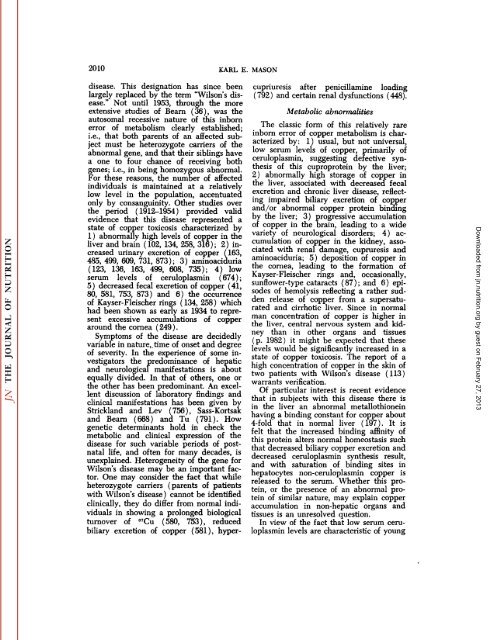conspectus of researchon copper metabolism and requirements
conspectus of researchon copper metabolism and requirements
conspectus of researchon copper metabolism and requirements
You also want an ePaper? Increase the reach of your titles
YUMPU automatically turns print PDFs into web optimized ePapers that Google loves.
2010 KARL E. MASON<br />
disease. This designation has since been<br />
largely replaced by the term "Wilson's dis<br />
ease." Not until 1953, through the more<br />
extensive studies <strong>of</strong> Beam (36), was the<br />
autosomal recessive nature <strong>of</strong> this inborn<br />
error <strong>of</strong> <strong>metabolism</strong><br />
i.e., that both parents<br />
clearly established;<br />
<strong>of</strong> an affected sub<br />
ject must be hétérozygote carriers <strong>of</strong> the<br />
abnormal gene, <strong>and</strong> that their siblings have<br />
a one to four chance <strong>of</strong> receiving both<br />
genes; i.e., in being homozygous abnormal.<br />
For these reasons, the number <strong>of</strong> affected<br />
individuals is maintained at a relatively<br />
low level in the population, accentuated<br />
only by consanguinity. Other studies over<br />
the period (1912-1954) provided valid<br />
evidence that this disease represented a<br />
state <strong>of</strong> <strong>copper</strong> toxicosis characterized by<br />
1) abnormally high levels <strong>of</strong> <strong>copper</strong> in the<br />
liver <strong>and</strong> brain (102, 134, 258, 316); 2) in<br />
creased urinary excretion <strong>of</strong> <strong>copper</strong> (163,<br />
485, 499, 609, 731, 873); 3) aminoaciduria<br />
(123,<br />
serum<br />
136, 163, 499, 608, 735);<br />
levels <strong>of</strong> ceruloplasmin<br />
4) low<br />
(674);<br />
5) decreased fecal excretion <strong>of</strong> <strong>copper</strong> (41,<br />
80, 581, 753, 873) <strong>and</strong> 6) the occurrence<br />
<strong>of</strong> Kayser-Fleischer rings (134, 258) which<br />
had been shown as early as 1934 to repre<br />
sent excessive accumulations<br />
around the cornea (249).<br />
<strong>of</strong> <strong>copper</strong><br />
Symptoms <strong>of</strong> the disease are decidedly<br />
variable in nature, time <strong>of</strong> onset <strong>and</strong> degree<br />
<strong>of</strong> severity. In the experience <strong>of</strong> some in<br />
vestigators the predominance <strong>of</strong> hepatic<br />
<strong>and</strong> neurological manifestations is about<br />
equally divided. In that <strong>of</strong> others, one or<br />
the other has been predominant. An excel<br />
lent discussion <strong>of</strong> laboratory findings <strong>and</strong><br />
clinical manifestations<br />
Strickl<strong>and</strong> <strong>and</strong> Lev<br />
has been given by<br />
(756), Sass-Kortsak<br />
<strong>and</strong> Beam (668) <strong>and</strong> Tu (791). How<br />
genetic determinants hold in check the<br />
metabolic <strong>and</strong> clinical expression <strong>of</strong> the<br />
disease for such variable periods <strong>of</strong> post<br />
natal life, <strong>and</strong> <strong>of</strong>ten for many decades, is<br />
unexplained.<br />
Wilson's disease<br />
Heterogeneity<br />
may be an<br />
<strong>of</strong><br />
important<br />
the gene<br />
fac<br />
for<br />
tor. One may consider the fact that while<br />
hétérozygote carriers (parents <strong>of</strong> patients<br />
with Wilson's disease ) cannot be identified<br />
clinically, they do differ from normal indi<br />
viduals in showing a prolonged biological<br />
turnover <strong>of</strong> 67Cu (580, 753), reduced<br />
biliary excretion <strong>of</strong> <strong>copper</strong> (581), hyper-<br />
cupriuresis after penicillamine loading<br />
(792) <strong>and</strong> certain renal dysfunctions (448).<br />
Metabolic abnonnalities<br />
The classic form <strong>of</strong> this relatively rare<br />
inborn error <strong>of</strong> <strong>copper</strong> <strong>metabolism</strong> is char<br />
acterized by: 1) usual, but not universal,<br />
low serum levels <strong>of</strong> <strong>copper</strong>, primarily <strong>of</strong><br />
ceruloplasmin, suggesting defective syn<br />
thesis <strong>of</strong> this cuproprotein by the liver;<br />
2) abnormally high storage <strong>of</strong> <strong>copper</strong> in<br />
the liver, associated with decreased fecal<br />
excretion <strong>and</strong> chronic liver disease, reflect<br />
ing impaired biliary excretion <strong>of</strong> <strong>copper</strong><br />
<strong>and</strong>/or abnormal <strong>copper</strong> protein binding<br />
by the liver; 3) progressive accumulation<br />
<strong>of</strong> <strong>copper</strong> in the brain, leading to a wide<br />
variety <strong>of</strong> neurological disorders; 4) ac<br />
cumulation <strong>of</strong> <strong>copper</strong> in the kidney, asso<br />
ciated with renal damage, cupruresis <strong>and</strong><br />
aminoaciduria; 5) deposition <strong>of</strong> <strong>copper</strong> in<br />
the cornea, leading to the formation <strong>of</strong><br />
Kayser-Fleischer rings <strong>and</strong>, occasionally,<br />
sunflower-type cataracts (87); <strong>and</strong> 6) epi<br />
sodes <strong>of</strong> hemolysis reflecting a rather sud<br />
den release <strong>of</strong> <strong>copper</strong> from a supersatu<br />
rated <strong>and</strong> cirrhotic liver. Since in normal<br />
man concentration <strong>of</strong> <strong>copper</strong> is higher in<br />
the liver, central nervous system <strong>and</strong> kid<br />
ney than in other organs <strong>and</strong> tissues<br />
(p. 1982) it might be expected that these<br />
levels would be significantly increased in a<br />
state <strong>of</strong> <strong>copper</strong> toxicosis. The report <strong>of</strong> a<br />
high concentration <strong>of</strong> <strong>copper</strong> in the skin <strong>of</strong><br />
two patients with Wilson's disease (113)<br />
warrants verification.<br />
Of particular interest is recent evidence<br />
that in subjects with this disease there is<br />
in the liver an abnormal metallothionein<br />
having a binding constant for <strong>copper</strong> about<br />
4-fold that in normal liver (197). It is<br />
felt that the increased binding affinity <strong>of</strong><br />
this protein alters normal homeostasis such<br />
that decreased biliary <strong>copper</strong> excretion <strong>and</strong><br />
decreased ceruloplasmin synthesis result,<br />
<strong>and</strong> with saturation <strong>of</strong> binding sites in<br />
hepatocytes non-ceruloplasmin <strong>copper</strong> is<br />
released to the serum. Whether this pro<br />
tein, or the presence <strong>of</strong> an abnormal pro<br />
tein <strong>of</strong> similar nature, may explain <strong>copper</strong><br />
accumulation in non-hepatic organs <strong>and</strong><br />
tissues is an unresolved question.<br />
In view <strong>of</strong> the fact that low serum ceru<br />
loplasmin levels are characteristic <strong>of</strong> young<br />
Downloaded from<br />
jn.nutrition.org<br />
by guest on February 27, 2013
















